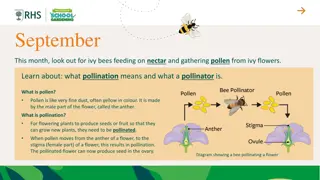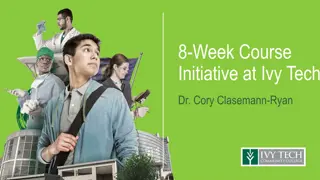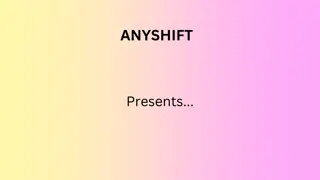Temporary Personal Care Attendant Training Program by Ivy Tech Community College
This training program, developed by Ivy Tech Community College as per ISDH course requirements, is designed for Temporary Personal Care Attendants (Waiver Aides) to address staffing shortages due to the COVID-19 pandemic. Candidates must be at least 16 years old with no specific educational requirements. The program includes classroom and simulation components, focusing on essential care skills and resident rights. Training standards emphasize proper documentation and observation by instructors or licensed nurses. The curriculum also covers HIPAA regulations, abuse prevention, and resident rights.
Download Presentation

Please find below an Image/Link to download the presentation.
The content on the website is provided AS IS for your information and personal use only. It may not be sold, licensed, or shared on other websites without obtaining consent from the author. Download presentation by click this link. If you encounter any issues during the download, it is possible that the publisher has removed the file from their server.
E N D
Presentation Transcript
Personal Care Attendant (PCA) Training Materials Developed By Ivy Tech Community College Per ISDH Course Requirements Temporary Personal Care Attendant (Waiver Aide) Eight (8) Hour Course 5 Hour Classroom 3 Hour Simulation/Competency Check-off
Implemented by Indiana State Department of Health (ISDH) Scope: The PCA position is temporary to address work increases and staffing shortages caused by the 2020 COVID-19 pandemic Under the directives of Governor Eric Holcomb s March 6, 2020 Declaration of Public Health Emergency for Coronavirus Disease 2019 Outbreak The PCA position will be authorized only while the Executive Order remains in effect, plus any additional time necessary to resume normal staffing
Personal Requirements A candidate for training must be at least sixteen (16) years old There are no minimum educational requirements A PCA who completes training and is employed by a facility must satisfy the criminal history requirements
Training Standards The training/hiring facility is responsible for all training documentation The PCA training course must be taught by a Nurse Aide Program Instructor for the ISDH Nurse Aide Program
Training Standards After classroom training, PCA students must practice and demonstrate ability to safely perform all required care skills The instructor or licensed nurse must observe each student s practice of required skills and document the student s ability to perform skills safely The PCA shall report to the facility s Charge Nurse/Manager
I. Resident Rights/HIPAA/Abuse & Neglect 15 minutes Resident Rights OBRA Omnibus Budget Reconciliation Act (OBRA) originated due to increased reports of abuse and neglect in nursing homes Purpose: to inform residents of rights and provide ethical code for healthcare workers What is ethics?
I. Resident Rights/HIPAA/Abuse & Neglect 15 minutes Resident rights include the right to: Choose a physician & participate in treatment decisions & care planning Be treated with dignity and respect Don t call the resident honey or sweetie as this is disrespectful Call the resident by their preferred name
I. Resident Rights/HIPAA/Abuse & Neglect 15 minutes The right to make his/her personal choices (resident-centered care) When to go to bed, when to get up When and what they wish to eat They also have the right to refuse care (notify charge nurse) Resident has rights to have personal items in room this is their home Must be safe Cannot interfere with rights of his/her roommate
I. Resident Rights/HIPAA/Abuse & Neglect 15 minutes Have his/her culture/beliefs respected Prayer time, spiritual advisors, dietary accommodations Have his/her protected health information treated as confidential The Health Insurance Portability and Accountability Act (HIPAA) Law to protect the privacy of protected health information Do not give resident information to anyone Respectfully explain confidentiality to families refer to charge nurse
I. Resident Rights/HIPAA/Abuse & Neglect 15 minutes The resident has the right to be free of abuse and neglect PCA's are responsible for protecting residents & preventing abuse/neglect Response to witnessed (or reported) abuse/neglect Must be reported if suspected or witnessed If witnessed, call for the nurse, stay/protect with the resident Immediate reporting of abuse and neglect to nurse/manager
I. Resident Rights/HIPAA/Abuse & Neglect 15 minutes Types of abuse Physical Sexual Mental/psychological incudes leaving resident in an embarrassing situation as punishment Verbal Financial
I. Resident Rights/HIPAA/Abuse & Neglect 15 minutes Neglect what you do or don t do causes harm/risk of harm example: not answering call lights as promptly as possible Involuntary seclusion Misappropriation (theft) Remember: Witnessed/suspicion of abuse/neglect MUST be reported to charge nurse
II. Infection Control 30 minutes How is infection spread? Infectious agent/pathogen Reservoir/infected host Portal of exit Mode of transmission Portal of entry Susceptible host
II. Infection Control 30 minutes According to ISDH on March 23, 2020: Due to shortages of face masks: Only direct care providers should wear masks while in facility Those essential providers should wear a surgical mask for the entire shift Masks should be conserved Only a single mask should be worn by staff each shift
II. Infection Control 30 minutes Hand hygiene: Handwashing is the single most effective way healthcare providers can reduce the spread of infection Requires a 20 second friction scrub on all surfaces of the hands/fingers Alcohol based hand rub use a quarter sized amount; rub into all surfaces of the hands/fingers Requires at least 10 second friction rub allow to dry to be most effective
II. Infection Control 30 minutes Cover coughs and sneezes (cough etiquette) Cover your mouth and nose with a tissue when you cough or sneeze or use the inside of your elbow Throw used tissues in the trash Immediately wash your hands with soap and water for at least 20 seconds If soap and water are not readily available, clean your hands with alcohol based hand rub
II. Infection Control 30 minutes Standard Precautions Consider the blood and body fluids of every resident as potentially infectious The minimum infection prevention practices that apply to all patient care Personal Protective Equipment (PPE) Gloves should be worn for contact with blood and/or body fluids Gown/Mask/Goggles should be worn during procedures and while giving personal care if splashing/spraying of blood, body fluids, etc. is likely or if there is a possibility of contact with any infectious material
II. Infection Control 30 minutes Transmission-based Precautions Airborne Precautions: pathogens transmitted by the airborne route Standard precautions + respiratory protection Droplet precautions: pathogens transmitted by respiratory droplets Standard precautions + masks & gloves if working within 3 feet of the resident Contact precautions: pathogens spread by direct or indirect contact Standard precautions + gowns if substantial contact with resident/surroundings
II. Infection Control 30 minutes Handling of linens Never shake linens Carry both clean and dirty linens away from uniform If linens are taken in to a resident s room, they cannot go back to the linen closet NEVER throw soiled linen on the floor
II. Infection Control 30 minutes Clean areas in the room: Dirty areas in the room: Back of chair Seat of chair Head of bed Foot of bed Over bed table Laundry bag/plastic bag Top of bedside cabinet Laundry hamper NEVER ON THE FLOOR!
II. Infection Control 30 minutes Miscellaneous infection control measures High touch areas include side rails and hand rails in hallway disinfect per policy Common use items need disinfected between residents Thermometers, lifts, scales, shower chairs, etc. Don t sit on the resident s bed; don t use anything that has been on the floor Note: The PCA will not be assigned to provide care or services to a resident in Isolation Precautions
II. Infection Control 30 minutes AIDS/HIV Destroys the immune system; resident will be vulnerable to infection Transmitted through infected blood or body fluid Vaginal/anal sex Sharing needles/syringes, tattooing/piercing, transfusion, organ transplant Mother to infant during pregnancy/childbirth/breastfeeding NOT possible to get from toilet seat, casual contact, kissing, or insects
II. Infection Control 30 minutes Clostridium Difficile (C-Diff) Caused by bacteria in the colon Usually due to antibiotic use Causes frequent watery stools with a distinct odor Cannot use hand rub - not effective against C-diff MUST wash hands with soap and water
II. Infection Control 30 minutes Procedures Review: Hand wash when visibly soiled/prior to care, scrub at least 20 seconds Hand rub quarter size amount of product, rub at least 10 seconds Gloving check fit/holes, remove without contaminating hands Gowning remove without touching outside of gown Masking normally removed after 30 minutes; now wearing entire shift
III. Emergency Procedures 15 minutes First two actions for all emergencies Call for the nurse Stay with the resident
III. Emergency Procedures 15 minutes Falls Prevention Awareness of residents who are at risk for falling Safety check of resident and environment before leaving room Answer call lights promptly, check resident frequently
III. Emergency Procedures 15 minutes Falls Intervention If resident begins to fall, never try to stop the fall instead ease them to the floor Call nurse, stay with resident then check to see if the resident is breathing Speak calmly to resident do not get them up until nurse has checked them After a fall, document, check resident frequently for remainder of shift If resident tells you he/she fell when no one was around, report to nurse promptly
III. Emergency Procedures 15 minutes Choking - Partial or complete airway obstruction Universal sign: holding neck, gasping noise or clutching throat Ask Can you cough? , Can you speak? If resident cannot cough or speak airway is completely obstructed Perform the Heimlich maneuver until object is expelled Do NOT perform this maneuver if the resident can cough or speak Airway is only partially obstructed, the Heimlich may completely obstruct
III. Emergency Procedures 15 minutes Procedures Review: Resident Observed Fallen or on the Floor (Falling/Fainting) Call for nurse, stay with resident, check breathing, do not move resident Choking Heimlich Maneuver Can they cough or speak? If NOT, perform Heimlich until object expelled
IV. Activities of Daily Living 120 minutes A. Initial Steps/Responding to a call light Procedure: Initial Steps Applicable Every Time the Resident Room is Entered Ask nurse about resident needs abilities, limitations Remember: 1. Resident rights 2. Infection control 3. Safety!
IV. Activities of Daily Living 120 minutes B. Obtaining a temperature (all routes other than rectal) Procedure: Oral Temperature (Electronic) NOT if resident is unconscious, on oxygen, or confused/disoriented Procedure: Axillary Temperature (axillary = armpit) Use this method if cannot take temperature orally Take resident s arm out of sleeve, dry armpit before placing sheathed thermometer
IV. Activities of Daily Living 120 minutes C. Making an unoccupied bed/handling of linens Procedure: Unoccupied Bed Remember clean and dirty areas in room Remove soiled linens by rolling them from head to foot of bed, place in bag/hamper Completely make bed on one side, including tucking/mitering corners THEN, make other side of bed and change pillowcase
IV. Activities of Daily Living 120 minutes D. Turning and repositioning the Resident while in bed Procedure: Assist Resident to Move to Head of Bed Easiest with 2 caregivers/draw sheet Procedure: Assisting Resident to the Supine Position Bed flat, resident on back and aligned Used for bedbath, changing incontinence brief, any time resident needs to be turned
IV. Activities of Daily Living 120 minutes D. Turning and repositioning the Resident while in bed Procedure: Assisting Resident to the Lateral Position Turning on either side, supported with 4 pillows (head, back, under arm, between knees) Used to get pressure off coccyx (tailbone) Procedure: Assisting Resident to the Fowler s Position Head of bed elevated to 45-60 degrees Used for ADL care, eating, etc.
IV. Activities of Daily Living 120 minutes E. Making an occupied bed Procedure: Occupied bed Turn resident away from you (side rail up on other side of bed) Tuck soiled bottom sheet under resident, place clean bottom sheet, tuck under resident Go to other side, turn resident away (side rail up on other side of bed) Remove soiled linens, finish placing clean bottom sheet Change top sheet while keeping resident covers, tuck, miter corners, change pillowcase
IV. Activities of Daily Living 120 minutes F. Transfer from bed to chair/wheelchair/Use of Gait belt- One person standby/transfer Procedure: Sit on Edge of Bed Prior to Transfer to Chair Place bed in position where resident s feet can touch floor, raise head of bed Assist resident to sit on side of bed using count of 3, check for dizziness 10-15 seconds Put on resident s shoes or non-skid socks/slippers, feet should be flat on floor
IV. Activities of Daily Living 120 minutes F. Transfer from bed to chair/wheelchair/ Use of Gait belt- One person standby/transfer Think about this: Does the resident need ASSIST or TRANSFER? The resident may need a little help (ASSIST) Stand on resident s affected side holding gait belt on side and back The resident may need more than a little help (TRANSFER) Stand in front of resident, toe to toe, holding gait belt on both sides
IV. Activities of Daily Living 120 minutes F. Transfer from bed to chair/wheelchair/Use of Gait belt- One person standby/transfer Procedure: Using a Gait Belt to Assist with Ambulation Place gait belt snugly around resident s waist, over clothing, buckle in front Since resident can ambulate (walk), they only need ASSIST to stand Stand on resident s affected side, hold gait belt at side and back Assist to stand on count of three, check for dizziness 10-15 seconds Hold gait belt/stand on affected side/slightly behind, walk at resident s pace
IV. Activities of Daily Living 120 minutes F. Transfer from bed to chair/wheelchair/Use of Gait belt- One person standby/transfer Procedure: Walking (Assist) Procedure is much the same as assist resident to ambulate with a gait belt Resident may or may not need a gait belt Stand to the side and slightly behind the resident, walk at resident s pace
IV. Activities of Daily Living 120 minutes F. Transfer from bed to chair/wheelchair/Use of Gait belt- One person standby/transfer Procedure: Assist with Walker Procedure much the same as assisting resident to ambulate with a gait belt Place walker in front of resident as close to bed as possible, stand on affected side Brace walker with your foot, place one hand on top of walker to secure Hold side of gait belt, assist resident to stand on count of three check for dizziness Ask resident to move walker 1st, then weak leg, then strong leg (walker, weak, strong)
IV. Activities of Daily Living 120 minutes F. Transfer from bed to chair/wheelchair/Use of Gait belt- One person standby/transfer Procedure: Transfer to Chair Place chair firmly against bed on resident s strong side Stand in front of them toe to toe, place resident s hands on your shoulders Hold sides of gait belt, assist to stand on count of three, check for dizziness Brace your feet and assist resident to turn to chair, lower resident into chair Align resident, remove gait belt
IV. Activities of Daily Living 120 minutes F. Transfer from bed to chair/wheelchair/Use of Gait belt- One person standby/transfer Procedure: Transfer to Wheelchair Procedure is much the same as transfer to chair Remember to lock the brakes of the wheelchair and move footrests out of the way Transport forward through open doors, backward through closed doors Remember to lock brakes once resident is at destination, remove gait belt
IV. Activities of Daily Living 120 minutes F. Transfer from bed to chair/wheelchair/Use of Gait belt- One person standby/transfer Note: For anything beyond a one-person transfer, the PCA may only assist and must be directed by a certified/licensed staff member
IV. Activities of Daily Living 120 minutes G. Bed bath/partial bath Procedure: Bed Bath/Perineal Care Most important consideration during the bathing process; comfort, safety and privacy Partial bath; face, hands, underarms, and perineal area; at least daily Full bath or shower; 2 times per week Perineal care includes pubic area, inner thighs, groin, genitalia, and anus Linens: 6 washcloths, 4 towels, bath blanket, clean gown/clothes Catheter Care - clean tubing starting from the opening to the bladder and wipe outward 4 inches
IV. Activities of Daily Living 120 minutes G. Bed bath/partial bath Procedure: Bed Bath/Perineal Care (continued) Start with warm water in basin, will be changing 3 times for total of 4 basins of water 1. Wash head to toe EXCEPT perineal area ( 1 washcloth, 1 towel) 2. Perineal area (2 washcloths, 1 towel) - away from the opening to the bladder circular motion 3. Anal area, buttocks (2 washcloths, 1 towel) cleaning front to back 4. Back (1 washcloth, 1 towel) Note: each time water is changes, wash hands, put on clean gloves, ask resident to check water temp
IV. Activities of Daily Living 120 minutes H. Assistance with Dressing/Undressing Procedure: Dressing a Dependent Resident Give resident a choice of clothing Dress Affected side first Undress Unaffected side first
IV. Activities of Daily Living 120 minutes I. Incontinence/Perineal Care Procedure: Application of an Incontinence Brief Put on gloves before removing the dirty brief Provide perineal care (peri-care) Change gloves/wash hands before applying a clean brief Place dirty brief in a bag and remove from room
IV. Activities of Daily Living 120 minutes J. Assist to Toilet/Use of urinal (only for a resident requiring one person/standby assist) Procedure: Assist to Bathroom When finished apply gloves, assist resident to wipe front to back Remove gloves, wash hands, assist resident to raise garments, help resident was hands Procedure: Urinal If using in bed, raise head of bed to a sitting position When finished, apply gloves, cover urinal, take to bathroom, check COCA, dispose, wash hands, assist resident to wash hands
IV. Activities of Daily Living 120 minutes K. Oral Care - conscious residents only Procedure: Oral Care for the Alert and Oriented Resident Oral care should be done daily, place in Fowler s position PCA can NOT perform oral care on an unconscious resident Check MLTT Mouth, Lips, Tongue, Teeth Check for OCSBDL Odor, Cracks, Sores, Bleeding, Discoloration, Loose teeth What is the phrase to help you remember what you are checking for? Oral Care Should Be Done Last
IV. Activities of Daily Living 120 minutes L. Devices/Use/Storage (Hearing Aids, Eyeglasses, Dentures) Procedure: Assisting with Hearing Aids You know it s working if it amplifies sound Always face resident when speaking Store hearing aids in the labeled case when not in resident s ear, can use a clean labeled denture cup Do not get hearing aids wet Clean according to manufacturer s instructions






























